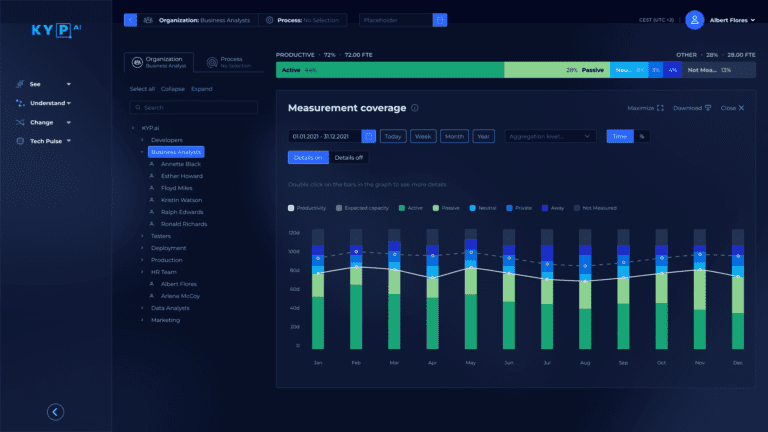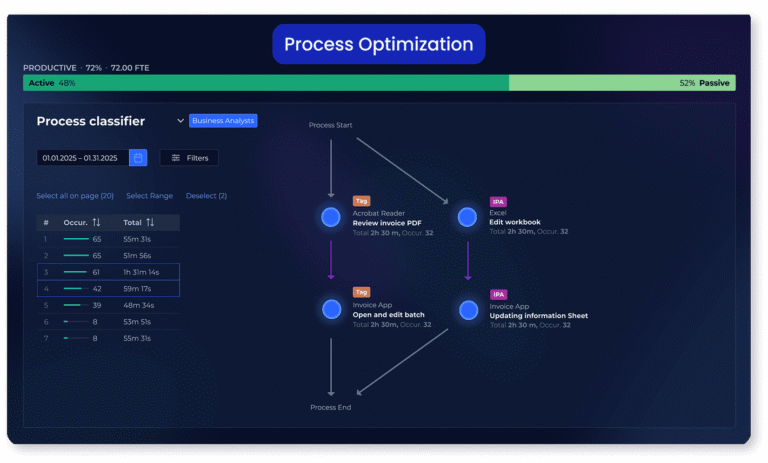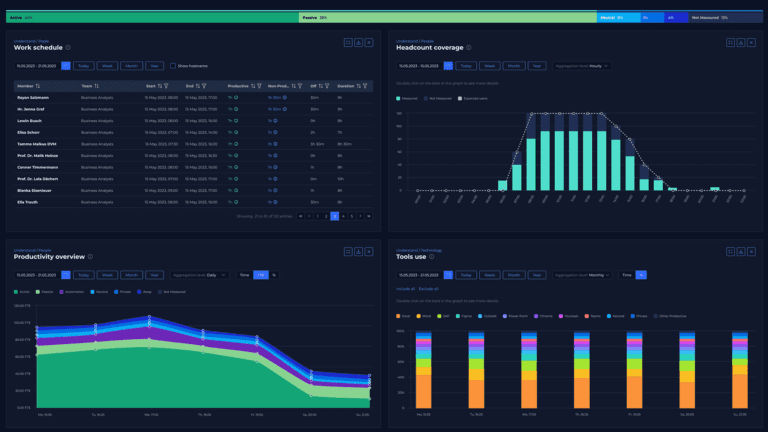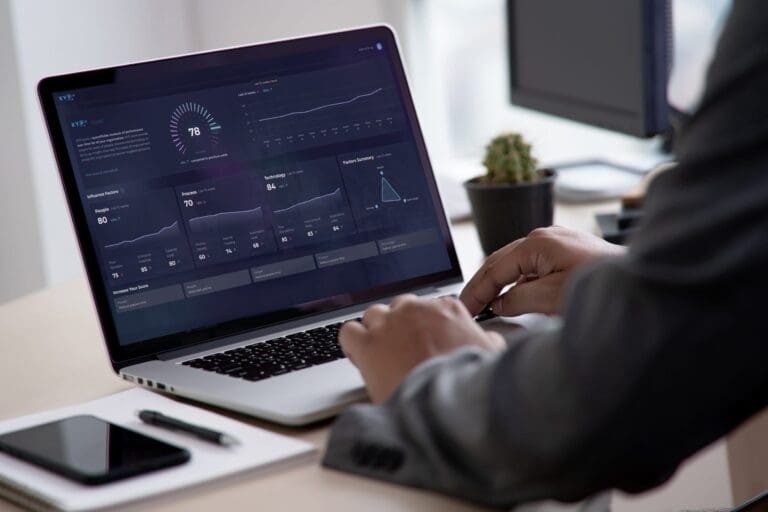Executive summary
Process mining gives enterprise leaders visibility into how work gets done across business operations and IT systems, enabling data-driven decisions and process improvements.
Key takeaways:
- Process mining replaces legacy process discovery methods with facts, providing objective visibility into how work actually flows through your organization versus documented procedures
- Event log based process mining analyzes system logs but misses human interactions. Modern process intelligence platforms like KYP.ai capture the complete picture across people, processes, and technology
- The next frontier combines process intelligence with autonomous AI agents that act on insights, requiring structured business context, ROI-driven prioritization, and production-ready agent code.
This guide explores how process mining transforms business operations, compares different process mining technologies, and outlines the path toward agentic AI-powered process transformation.
What is process mining?
Process mining is a technique that analyzes event logs from enterprise systems like ERP, CRM, and other business applications to create visual models of actual process execution. Every digital action – from creating an invoice, updating a customer record, processing an order – generates timestamped data that process mining algorithms reconstructs into end-to-end process flows.

This technology reveals not just the intended process path, but all variations, deviations, and bottlenecks that occur in practice. It’s like having GPS for your business operations, showing where processes run smoothly and where delays, redundancies, or unnecessary steps slow performance.
Key capabilities of process mining:
- Process discovery – Automatically detects workflows by analyzing system event logs, revealing how processes actually execute versus documented procedures
- Process performance analysis – Measures cycle times, identifies bottlenecks, and quantifies the impact of inefficiencies in terms of time and cost
- Conformance checking – Compares actual process execution against intended models to identify deviations and compliance gaps
- Process enhancement – Provides insights for optimization by highlighting improvement opportunities based on actual execution data
Why process mining still matters today
Process mining is not a new technology. It emerged in the late 1990s as a sub-set of data mining. By the early 2000s we saw the first process mining algorithms, and today Gartner tracks almost 40 different process mining solutions from free-to-use solutions like ProM to agentic process intelligence solutions like KYP.ai.
Process mining matters in today’s competitive business landscape because it:
- Replaces assumptions with facts. Traditional process analysis methods rely on interviews, workshops, and manual observation. These methods are subjective, time-consuming, and capture only snapshots of reality. Process mining provides objective, comprehensive, and continuous visibility into operations.
- Gives transparency into business operations. Process mining illuminates how work really gets done, exposing hidden inefficiencies that manual mapping misses. This fact-based view is essential for meaningful improvement efforts.
- Enables compliance and governance. As regulatory requirements intensify, process mining verifies whether processes follow established rules and highlights deviations. This is critical in heavily regulated industries like financial services and healthcare where compliance is non-negotiable.
- Supports data-driven decision making. In an era where data determines competitive advantage, process mining enables organizations to base strategic decisions on evidence rather than intuition. By analyzing real execution data, companies can optimize operations to cut costs, reduce cycle times, and improve service delivery.
Key benefits of process mining
Process mining delivers substantial value across analytical and monetary dimensions. According to Deloitte’s 2025 Global Process Mining Study, organizations report significant improvements in operational performance, with 80% of current users agreeing that process mining delivers added value, and 49% reporting increased satisfaction over the past 12 months.
Improved operational efficiency
Operational efficiency represents the most compelling benefit of process mining. Organizations using the technology report dramatic improvements in process execution:
46% of organizations achieved reduced throughput times, dramatically improving process cycle speeds. 41% successfully reduced manual effort through targeted process improvements, while 26% reported working capital reduction, driving significant financial efficiency gains.
By mapping actual process flows, organizations identify repeated actions, delay points, and simplification opportunities. This visibility enables streamlined operations and waste elimination for optimal resource utilization. Process mining identifies variations from standard procedures that cause inefficiencies, allowing organizations to ensure processes run as lean as possible.
Continuous monitoring capabilities mean optimized processes maintain peak performance—the system alerts teams when processes drift from their optimized state for quick correction.
Process transparency and optimization
61% of organizations highlight process transparency as a key benefit, emphasizing the importance of gaining operational oversight, a marked increase from 38% in 2021. This visibility proves essential for identifying improvement opportunities.
49% of organizations identified tangible process optimization measures, showcasing the tool’s ability to deliver transformative improvements. Organizations successfully implement concrete actions based on process mining insights, moving beyond analysis to measurable results.
Measurable financial impact
The monetary value generated through process mining proves substantial. 21% of organizations report savings exceeding €5 million, while 13% report savings between €1 million and €5 million. An additional 32% report savings in the range of €100,000 to €1 million.
These savings result from specific improvement initiatives: 34% of organizations achieved monetary savings through improved cash discount realization, demonstrating the technology’s ability to identify and capture concrete financial benefits.
Customer satisfaction and service quality
30% of organizations report increased customer satisfaction thanks to shorter lead times, faster responses, and higher quality. By optimizing process execution, organizations deliver better customer experiences while simultaneously improving internal efficiency.
Compliance and risk reduction
20% of organizations report improvements in compliance, including reduced red flags and non-compliant events,a capability not reported in previous surveys, indicating expanding use cases for process mining.
This capability proves particularly valuable in regulated industries where audit trails and process documentation are mandatory. Process mining creates comprehensive audit records automatically, reducing manual documentation burden while ensuring accuracy and completeness.
Strategic value across operations
Process mining delivers value beyond immediate efficiency gains. 10% of organizations utilize process mining for system migration support in large-scale IT transformations, demonstrating its versatility as a strategic enabler for broader digital transformation initiatives.
The combination of analytical insights and monetary returns positions process mining as a critical tool for operational excellence, enabling organizations to achieve sustained competitive advantage through data-driven process optimization.
How to compare process mining software
Selecting the right process analysis technology requires understanding how different approaches address organizational needs. The landscape spans from traditional process mining solutions to task mining tools and modern agentic process intelligence platforms.
Process mining vs. task mining
While often confused, process mining and task mining serve different purposes and capture different types of operational data:
| Aspect | Process Mining | Task Mining |
| Primary Focus | System-level workflows and transactions | Individual desktop activities and user actions |
| Data Source | Event logs from enterprise systems (ERP, CRM) | Screen recordings, user interface interactions |
| Visibility Scope | End-to-end processes across systems | Task-level execution on individual workstations |
| Deployment | Requires system integration and log extraction | Lightweight agents on user desktops |
| Best For | Understanding process flows across applications | Identifying automation opportunities in repetitive tasks |
| Limitations | Misses human activities outside systems | Limited to individual user scope, privacy concerns |
| Implementation Time | Weeks to months (system integrations) | Days to weeks (agent deployment) |
A modern process intelligence approach
Process intelligence solutions like KYP.ai represent the evolution beyond traditional process mining, capturing comprehensive operational reality without requiring event log extraction from ERP systems.
How modern process intelligence works:
- Lightweight data collection – Deploy non-intrusive agents across workstations that capture actual user interactions, application usage, and workflow execution in real-time
- 360° visibility – Automatically map how work flows across people, processes, and technology, including human activities, system interactions, and cross-application workflows
- AI-driven analysis – Advanced algorithms identify patterns, inefficiencies, and automation opportunities across the complete operational landscape
- Continuous intelligence – Real-time monitoring and insights that reflect current operational reality, not historical snapshots
How to identify your best-fit process intelligence solution
The process mining software market includes vendors ranging from established enterprise platforms to specialized solutions.
When evaluating options, consider these critical factors:
- Scope of visibility – Does the platform capture only system logs, or does it provide comprehensive visibility including human activities and cross-system workflows?
- Deployment complexity – How much IT involvement and system integration is required? Modern solutions should deploy rapidly with minimal technical overhead.
- Real-time capabilities – Does the software provide historical analysis only, or continuous real-time monitoring and alerts?
- AI and automation enablement – Can the platform identify automation opportunities and generate specifications for RPA or agentic AI deployment?
- ROI measurement – Does the solution quantify improvement opportunities and track actual impact of optimization initiatives?
- Privacy and compliance – What controls exist for data anonymization, access management, and regulatory compliance?
For a detailed comparison of leading process mining platforms explore our comprehensive process mining software comparison guide.
The future of process mining is agentic
The next frontier of business process transformation combines process intelligence with agentic AI, or autonomous agents capable of executing complex workflows end-to-end without human intervention.
While traditional process mining reveals what happens in operations, agentic process intelligence enables AI agents to act autonomously on those insights with precision and measurable ROI.
This represents a fundamental shift: from process visibility to autonomous process transformation.
How process intelligence unleashes agentic AI in enterprise
The promise of agentic AI hinges on three critical requirements that traditional process mining cannot satisfy:
- Rich, structured business context – AI agents need deep understanding of not just what to do, but why, when, and how,including company-specific nuances, dependencies, exceptions, and decision logic that exists beyond system logs
- ROI-driven prioritization – Organizations must distinguish between what CAN be automated versus what SHOULD be automated based on actual business impact, quantified in terms of cost, time, and strategic value
- Production-ready agent code – Autonomous agents require clear objectives, detailed action sequences, and executable instructions they can reliably execute at scale across diverse systems and workflows
Traditional process mining provides system log data that shows transaction flows within applications. However, this system-centric view lacks the complete operational context, human decision-making patterns, and executable specifications that agentic AI demands to operate reliably in complex enterprise environments.
KYP.ai: pioneers in agentic process intelligence
KYP.ai is the only platform purpose-built to enable enterprises to successfully deploy autonomous AI agents at scale by providing the three essential ingredients for agentic AI success.
What makes KYP.ai different:
360° Organizational View – Captures and correlates comprehensive data across people, processes, and technology. This can come from granular task-level execution to workforce behavior patterns to system interactions. This complete visibility exposes operational inefficiencies and provides the rich business context AI agents need to operate reliably in real-world enterprise environments.
Business Transformation Engine – Converts raw operational data into actionable intelligence by quantifying inefficiencies and calculating automation ROI with precision. Prioritizes high-impact opportunities aligned with strategic business goals, ensuring you automate what should be automated based on measurable business value, not just what can be automated technically.
Agentic AI Enabler – Generates structured business context, detailed action specifications, and production-ready AI agent code. The result: you can deploy autonomous agents with everything they need to execute complex workflows reliably at enterprise scale. The Productivity 360 platform works seamlessly across Windows, MacOS, legacy systems, and enterprise applications.
Proven outcomes with KYP.ai’s agentic AI empowerment:
- Weeks to deployment, not months – Rapid implementation with actionable insights within days
- 20-30% process time reduction across operations through intelligent automation
- 40-60% reduction in risk incidents with continuous compliance monitoring
- 6-12 month ROI timelines with measurable, sustained business impact
KYP.ai provides the complete foundation for agentic AI success in enterprise environments: structured business context that captures operational reality, ROI-driven prioritization that targets high-value opportunities, and production-ready agent code that enables reliable autonomous execution.
Discover Your Agentic Process Potential – Book a demo to see how KYP.ai’s agentic process intelligence platform transforms operational data into autonomous AI-powered process transformation.
Conclusion
Process mining has evolved from niche data mining technology into a business-critical capability for organizations pursuing operational excellence. By providing fact-based visibility into actual process execution, it enables data-driven decisions that reduce costs, improve efficiency, and enhance customer experiences.
As process intelligence integrates with emerging technologies like agentic AI, its transformative potential accelerates dramatically. Organizations that adopt modern process intelligence platforms position themselves not just for incremental improvement, but for autonomous process transformation that delivers sustained competitive advantage.
Frequently asked questions about process mining
How quickly can we see ROI from process mining?
Organizations typically achieve positive ROI within 6-12 months. Modern process intelligence platforms like KYP.ai deliver actionable insights within days of deployment, with measurable outcomes including 20-30% process time reduction, 15-25% cost savings, and 40-60% fewer compliance incidents. The key is selecting a platform that provides rapid deployment and continuous monitoring rather than point-in-time analysis.
We’ve already invested in process mining tools. Why should we consider process intelligence?
Traditional process mining analyzes system logs from ERP and CRM applications, providing a system-centric view. However, this misses the human layer: how employees actually interact with systems, handle exceptions, and execute work across multiple applications. Process intelligence platforms capture the complete picture across people, processes, and technology, revealing the 30-40% of operational reality that system logs alone cannot see. Many organizations find their process mining investments deliver limited value because they lack this comprehensive visibility.
How do we prioritize which processes to optimize first?
Modern process intelligence platforms include built-in ROI calculation engines that quantify the business impact of each improvement opportunity in terms of time saved, cost reduced, and risk mitigated. Rather than relying on assumptions about which processes matter most, the platform analyzes actual operational data to rank initiatives by measurable business impact, implementation effort, and strategic alignment. This ensures your team focuses on high-value opportunities rather than easy wins that deliver minimal return.
How can process intelligence help us demonstrate value in global business services?
GBS and shared services centers face existential pressure to prove strategic relevance. Process intelligence provides the quantitative evidence needed to demonstrate value: real-time capacity utilization data, measurable efficiency gains, and documented cost savings. By showcasing 20-30% process improvements and accelerating enterprise-wide automation adoption, GBS teams position themselves as transformation hubs rather than cost centers. The platform also enables proactive workforce management, ensuring you can do more with existing resources rather than facing headcount reduction pressure.
Can process intelligence work across our global operations with different systems and languages?
Yes. Modern process intelligence platforms deploy lightweight agents that capture operational data regardless of system, language, or geography. Unlike traditional process mining that requires separate integrations for each ERP or CRM instance, process intelligence works across Windows, MacOS, legacy systems, and enterprise applications universally. Organizations with operations spanning 10+ countries and dozens of disparate systems successfully gain unified visibility through a single platform deployment.
How do we scale process improvements across multiple geographies without an army of consultants?
Process intelligence platforms automate what traditionally required extensive consultant engagement. Rather than conducting interviews and workshops in each location, the platform continuously captures and analyzes how work actually gets done across all sites. This reveals best practices that can be standardized, identifies location-specific inefficiencies, and quantifies the impact of scaling improvements globally.
Can we use process intelligence to optimize our service delivery without invading employee privacy?
Yes. Enterprise-grade process intelligence platforms include comprehensive privacy controls: automatic PII/PHI detection and masking, granular data anonymization, role-based access controls, and compliance with GDPR, SOC2, and HIPAA. The focus is on understanding process flows and identifying improvement opportunities, not surveilling individual employees. Organizations successfully optimize operations while maintaining employee trust and meeting regulatory requirements.
How do we measure and prove the business impact we’re delivering to clients?
Process intelligence platforms provide real-time dashboards that track KPIs meaningful to clients: cycle time reduction, error rate improvement, SLA compliance, cost per transaction, and quality metrics. Rather than relying on anecdotal success stories, you provide quantitative evidence of continuous improvement. The platform automatically generates executive reports showing month-over-month trends, making quarterly business reviews data-driven conversations about measurable value delivery rather than defensive discussions about costs.
Discover Your Productivity Potential – Book a Demo Today
Book Demo








